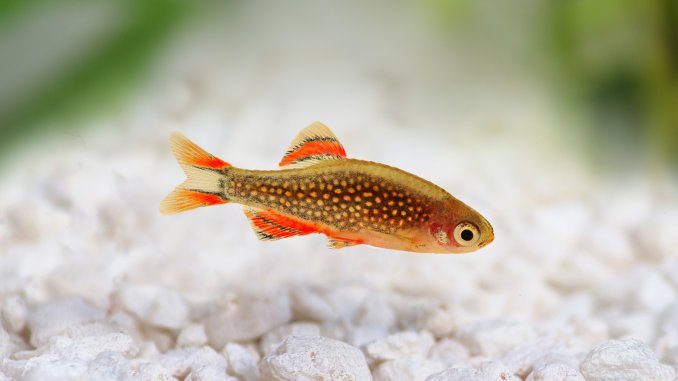
The celestial pearl danio is a freshwater fish in the danio family. These fish have dark blue bodies with white or yellow dots resembling a galaxy.
Celestial pearl danios are active and peaceful. The species is popular among aquarists due to its easy temperament and unique pattern.
TABLE OF CONTENTS
Celestial Pearl Danio Fats & Overview
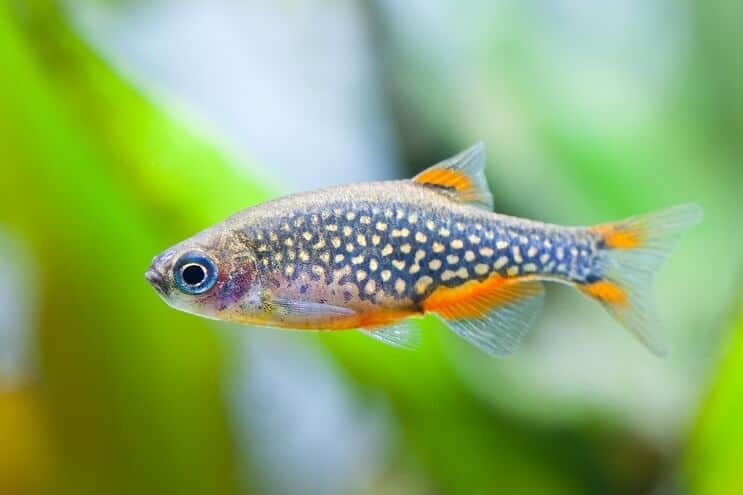
| Scientific name: | Danio margaritatus |
| Common names: | Celestial pearl danio, galaxy rasbora, fireworks rasbora |
| Distribution: | Myanmar and northern Thailand |
| Size: | 0.75–1 inch |
| Life expectancy: | 3–5 years |
| Color: | Dark blue with white/yellow spots in a galaxy pattern |
| Diet: | Omnivore |
| Temperament: | Peaceful |
| Minimum tank size: | 10 gallons |
| Temperature: | 71–78°F (21.6–25.5°C) |
| pH: | 6.5–7.5 |
| Hardness: | 1–5 dGH |
| Care level: | Moderate |
| Breeding: | Egglayer |
Distribution
Celestial pearl danios are native to freshwater ponds that are surrounded by rice paddies and grassland. These fish are commonly found in the Salween river basin area of the Shan Plateau in Myanmar.
The ponds, with an average depth of 12 inches, have slow-moving, clear water. Many aquatic plants and rocks, provide shelter, food, and spawning ground.
This fish species is common in the wild, though it almost became extinct due to its popularity with aquarists. Breeding in captivity has allowed the species to flourish in the wild.
Adult Size & Lifespan
Adult celestial pearl danios grow to be ¾–1 inch in length. These fish live between three and five years in captivity when well cared for.
Availability
Celestial pearl danios can be found in many pet stores. The fish are typically sold in shoals of 5 to 10. The cost ranges from $9.99 for one, to $69.99 for a shoal of 10.
Celestial pearl danios are available at these online stores:
Appearance & Behavior
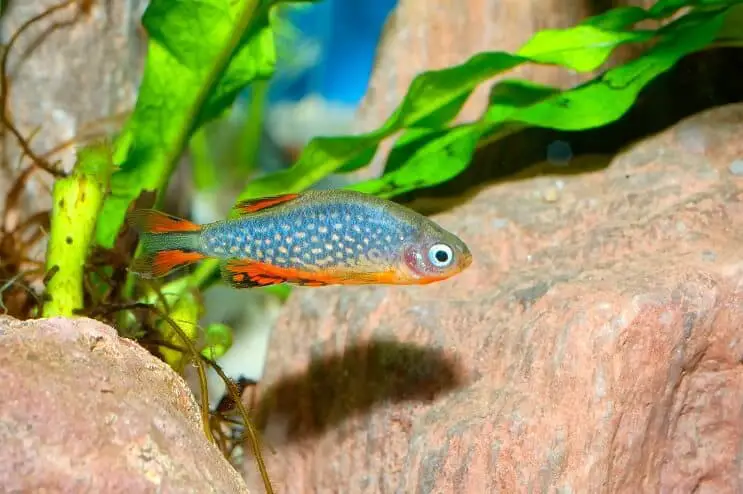
Celestial pearl danios have blue bodies with pearly dots and reddish fins. Like most other danios, these fish are peaceful.
Colors, Patterns, Fins, and Sex Differences
Celestial pearl danios have a narrow, fusiform body with prominent fins. Males are thinner and brighter, with a deep blue body and pearlescent spots all over the flanks. These dots are sometimes arranged in rows or in a galaxy pattern.
Males have a red stripe, lined with black, that runs through the middle of the fish’s nearly-translucent dorsal fin. Males also have a red belly, and dominant males have a red stripe on their backs.
Female celestial pearl danios aren’t as brightly colored and have less-bright pearly dots. On females, instead of red dorsal, pelvic, and caudal fins, these fins are orange and the anal fin is translucent.
Some females have an orange belly, while others have a golden belly. When they are ready to spawn, the females develop a black spot in front of their caudal fin, and the area becomes plumper.
Typical Behavior
Celestial pearl danios prefer to live in shoals of 10 or more. Keep more females than males in a tank because males will fight over the females.
This species hangs out in the bottom strata of a tank where it hides among rocks and aquatic plants. During feeding time, the fish swim to the middle and top strata.
Celestial Pearl Danio Care & Tank Requirements
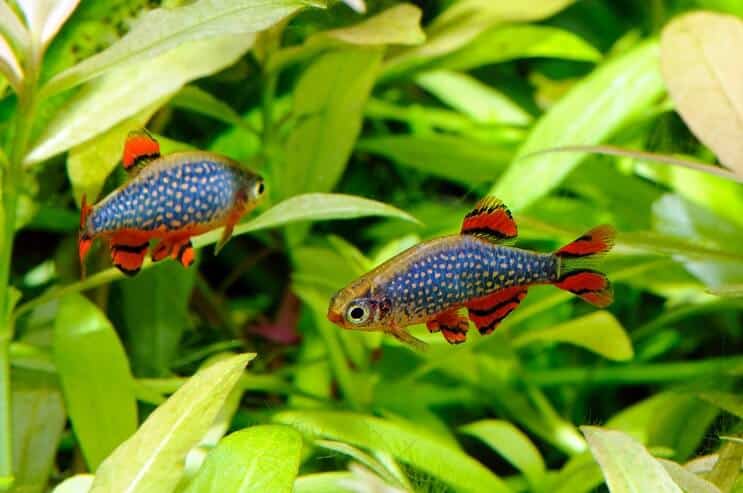
Celestial pearl danios are moderately easy to care for, but these fish become stressed easily which results in ill health.
In their natural habitat, these fish like to hide among the rocks and plants, so make sure tanks contain heavy vegetation. Don’t put a strong pump or current generator in the tank.
These fish are omnivores, so feed them a combination of dry fish flakes, pellets, and freeze-dried or live invertebrates.
Habitat and Tank Requirements
A 10-gallon tank is ideal for a shoal of five to seven celestial pearl danios. This tank size ensures that there’s plenty of space for the active fish to swim.
The species needs cool, clean water with low salt and mineral levels to mimic the fish’s natural habitat. The tank water should be pH neutral.
Strong filtration via canister or power filters ensures there aren’t too many pollutants in the water. Block the inlet tubes of the filtration system with sponges to prevent fish from getting sucked into a tube.
Lighting should be moderately bright, so use bright LED lights.
Include a multitude of aquatic plants like elodea, egeria, Java fern, bacopa, and rotala. Add floating plants like water lettuce or frogbit to provide top cover. The fish will snack on these plants and the vegetation provides hiding space for the shy celestial pearl danios. Decorate the tank with rocks to increase hiding spots.
Don’t add driftwood or leaf litter to the tank as these release tannins into the water, which can be unhealthy for the fish.
For easy maintenance, choose a sandy substrate or use smooth gravel to avoid injuring the fish.
Tank Conditions
The celestial pearl danio needs the following tank conditions to thrive:
| Water type: | Freshwater |
| Tank size: | Minimum 10 gallons for 5–7 fish, or minimum 20 gallons for 8–15 fish |
| Water temperature: | 71–78°F |
| Substrate: | Preferably dark, fine sand |
| Tank setup: | Bright lighting, caves, rockwork, plants |
| Acidity: | 6.5–7.5 pH |
| Water hardness: | 1–5 dGH |
| Filter: | Strong filtration |
| Water movement: | Slow-moving |
| Water region: | Bottom strata |
| Water heater: | No, because these fish prefer cool or cold water |
The celestial pearl danio needs swimming space and lots of hiding places in a small tank. Ensure the water requirements mimic this species’ cold, freshwater habitat.
Disease
Celestial pearl danios are prone to common fish diseases, particularly fin rot.
Fin rot causes a fish’s tail to become discolored or to rot. The disease is caused by poor water conditions, fighting, and fungal/bacterial infections.
Fin rot treatment includes antifungal medication or antibiotics, depending on severity. Prevent fin rot by monitoring the pH and temperature of the water. Also, ensure that there aren’t more males than females in the tank.
Celestial Pearl Danio Tank Mates
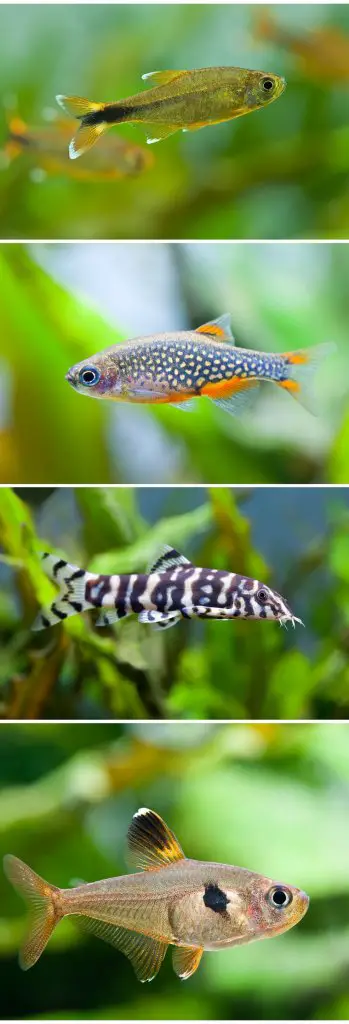
Because celestial pearl danios are tiny and peaceful, house them with other peaceful fish or fish that prefer the upper tank strata. Avoid large, aggressive fish that can eat this species.
Great tank mates for celestial pearl danios include:
- Other danios
- Pygmy hatchet fish
- Guppies
- Molly fish
- Cherry shrimp
- Amano shrimp
- Killifish
- Regular, ember, cardinal, or green tetras
- Honey or sparkling gourami
- Cory catfish
- Endler’s livebearer
- Kuhli loaches
- Snails
Unsuitable tank mates for celestial pearl danios include:
Keeping Celestial Pearl Danios Together
Celestial pearl danios live in groups, so you should try to keep a group of 5 or 6; this will help keep them all healthy and active.
Keep an eye on how many males you have if your tank is small. In a small tank with few hiding places, males who are less dominant will be subject to attacks from other males.
To keep all individuals safe, ensure that you have plenty of room for fish to live and keep a healthy ratio of males to females. Including plants will give them a natural feel and also gives the males a good hiding place for when they start competing for females.
Diet and Feeding
In their natural environment, celestial pearl danios are omnivorous and eat plankton, plants, algae, and small vertebrae. In captivity, feed this species a varied diet, two to three times a day. To prevent overfeeding and poor water quality, remove any uneaten food after five minutes.
Popular foods for celestial pearl danios include:
- Finely crushed dry flakes
- Micro pellets
- Small white worms
- Moina
- Daphnia
- Grindal worms
- Newly hatched brine shrimp
- Finely ground freeze-dried krill
- Frozen cyclops
Breeding
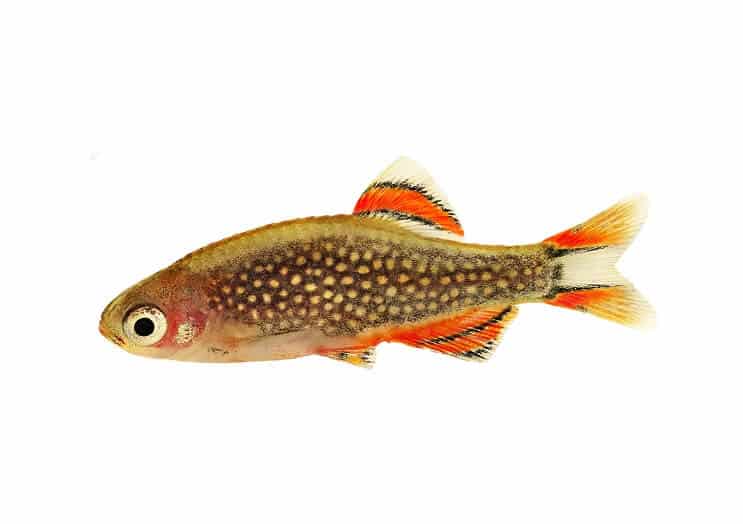
Celestial pearl danios are one of the easiest fish to breed. Once the fish are sexually mature, at three or four months of age, males and females try to breed daily.
Set up a breeding tank with Java moss or a spawning mop, aged water, aquatic plants, and an air-powered sponge filter. Add a male and female pair, or a male and a few females to the breeding tank.
When the female is ready to spawn, it develops a dark spot near the caudal fin. After the female lays her eggs, remove the adult fish from the breeding tank.
The eggs hatch in two to four days. Feed the fry micro foods for a week and then introduce newly-hatched brine shrimp.
Should You Get a Celestial Pearl Danio for Your Aquarium?
The celestial pearl danio, with its galaxy-patterned body and red fins, is an easy and beautiful addition to aquariums.
A celestial pearl danio is a good addition to a community tank where other small and peaceful fish species thrive. However, these fish aren’t a good addition if the tank already has a large or aggressive fish population.
Celestial Pearl Danio FAQs
- Are celestial pearl danios aggressive?
- Is the celestial pearl danio a schooling fish?
- Will celestial pearl danios eat shrimp?
- Where are celestial pearl danios from?
- What do celestial pearl danios eat?
- Are celestial pearl danios fin-nippers?
- How many celestial pearl danios should be kept in a 5-gallon tank?
- How many celestial pearl danios should be kept in a 10-gallon tank?
- Are celestial pearl danios easy to keep?
- How many celestial pearl danios should be kept together?

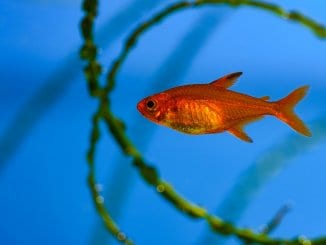
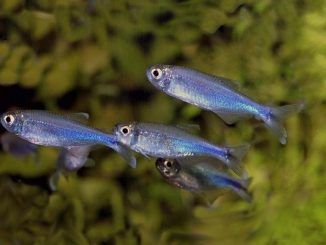
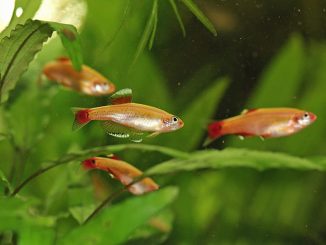
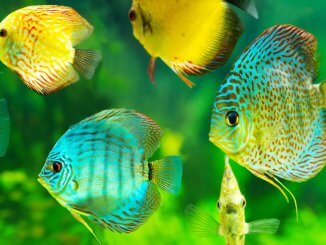
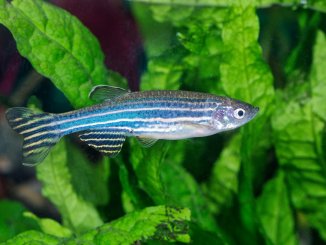
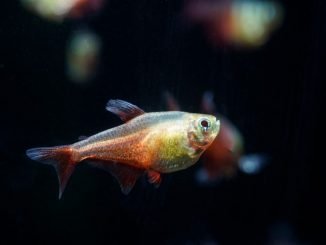
I have 3 and just ordered 6 more. They are tiny and fun.
I bought the last 4 babies from a lfs and they quarantined well before adding in with some neon tetras. We’ve enjoyed them and I’m looking for to add more. Would like to find a site that has photos of the growth so I can better understand how old they were when purchased.
Have 6 of these with guppies, tetras, discus and clown loaches. Fit in fine, discus leave them alone, no snacking. Great addition to the tank
Thank you for your articles!
We have two groups of celestial danios. The first group of 9 are mostly greenish, with the males being more blue. The second group of 15 is darker overall, and the males are almost black. Striking difference in appearance, although exactly alike in every other way. Two different breeders, we guess. Both have fins more orange than red and both spawn almost daily, usually within an hour of turning the lights on in the morning.
Due to the lower population density, the smaller group does best with actually completing spawning. The larger group contains so many males (6m/9f), they spend most of their time chasing each other off and the time it takes for one of them to finally pin one of the females is much longer and often interrupted. I think an ideal number is no more than about three males to about ten females. Only a small number of females are ripe at any given time and so as they rotate through, any males are concentrated on only the few ready females. As it is, we get plenty of spawning, but it’s a meelee…
They are sporadically available here (Maryland) and you really should get them when they first arrive at the shop. I typically see them look good upon arrival, but they are tiny, probably 1/2″ long and very limited as to what they can eat. As time goes on, the remaining fish in the tank lose condition and are often very skinny after a couple weeks, like they cannot eat most whatever they are being given. I had been feeding our little ones chopped up blackworms and brine shrimp, and ‘First Bites’ powdered food. I had the dark batch about two weeks and when I went past their original tank in the store, I could see the remnants were half the size of ours and stunted-looking.
Because we have corys in the tanks that have learned to follow the spawning celestials around, and because any surviving fry would be at the mercy of the adult celestials, which hunt intensely almost all of the time, we have yet to see a baby celestial. Just as well, the cory population kind of exploded on us and we don’t want even more tanks.
We also have an increasing number of about 50 cherry shrimp that reproduce freely in the community fish tanks and it seems that if the shrimp can get to about 1/4″ long, the celestials don’t bother them. We see this in both celestial tanks. You can see the celestials coming over and sizing them up, but then turning off. When we feed adult brine shrimp to the celestials, they are borderline too big for them. They have to work on one for awhile before they get it down and these brine shrimp are much more ‘feathery’ then the cherry shrimp of the same size.
A quick update (11-23-19):
Our dark batch of celectials have produced several groups of babies with individuals that have survived in a heavily planted 40 gallon breeder tank.
We have had a case of “give and take”, where several barely mobile babies will show up, looking like a hair with eyeballs, then, within a day or two, they’re all gone but one or two. I have a horizontal beech limb in the tank about 2/3rd of the way up toward the surface, with several clumps of various mosses, some well infested with hair algae, spaced along it’s 24″ length and the babies show up in and around the moss. As those one or two survivors grow, we will see more tiny fry appear, then most will disappear again, leaving one or two.
As a result, I currently have 11 fry between 3/8″ long and barely big enough to see, probably at least 4 or 5 age classes. The largest ones are getting their color and are moving about among the adults with impunity. The smallest three have been in there a week and seem to have learned to avoid the adult fish, so they’ll probably make it too.
I have several spawning sites in the 40-B tank; several Java Moss clumps tucked into rock crevices near the bottom, a group of small ‘Wendtii’ crypts planted along a sumberged beech limb lying on the bottom, and a cluster of Java Ferm mounted on a piece of driftwood about 8″ long. The root mat around the convoluted strip of driftwood is very thick and if I had to guess, I’d say most of our survivors came up from that impenetrable tangle.
The odds against survival in a community tank (Celestial Danios, Corydoras, Otocinclus & cherry shrimp)are incredible:
1) Any following males not actually involved in the spawn will quickly grab any loose eggs and look carefully for more.
2) The corydoras I have for cleanup know what spawning time is and will stage themselves at strategic points and eat the eggs as soon as the fish move off. I have larger size gravel in known spawning areas, but the corys are like little vacuum cleaners. I can distract them with blackworms if I need to, but they are pretty persistent.
3) The shrimp, corys and otocinclus constantly search the bottom for anything edible, so most eggs that do happen to make it past the spawing/feeding meelee, as well as fry still working off a yolk sac, get snuffled up. I know the Otos are supposed to be vegetarians, but that is not strictly the case. The shrimp will eat anything and will often catch a blackworm and then fight to keep it.
4) The adult Celestials, most notably the adult females, hunt constantly and with great focus. I have wild daphnia, cyclops, planaria and scuds in the tank and the fish hunt for them, as well as for their own fry. The adult female Celestials literally worm their way through the moss and algae searching for prey.
5) The newly mobilized fry are microscopic and finding food for them can be challenging. I found that the “First Bites” I was recommended is a little too big and they can only eat a very few tiny chips of it. I may have lost some of the early fry because they couldn’t get enough to eat. I have been using a fine powder consisting of krill and spirulina they they eat readily. Once they are a couple weeks old, they can eat more of the ‘First Bites’ and frozen daphnia.
Wow good info. Thanks
Very helpful. Thank you!
This is awesome! Thanks so much!
Put a pair of pearl danios with a single male clown killifish of flagfish
Feeding fry as small as that is problematic. I hard boil an egg then mash the yolk and liquifry it. It can be drip fed from a pipette or by a syringe
Thank you for that information. I’m trying different ways of breeding them. Haven’t had a huge success yet, but I’m learning. I have about 20 fry that I’m babying right now. I feed them powder.
I know this is very old, Ed, but how did the fry end up?
We have a 45 litre tank currently with 3 Platty, 4 Neon Tetra and 2 Danio a couple of Netrite Snail and 4 ghost shrimp, the tetras and danio are pretty hard to tell if they are male or female, but the platty i know i have 2 female and 1 male, i now have 9 platty fry and i was concerned that they would be eaten from reading various articles but they were left alone straight away and are growing at a rapid rate!
Would the celestial be a good addition? I LOVE the danio’s and these are stunning!
I have just bought eight of these beautiful little fish from my local fish shop. I tried to get more females than males, but I think I ended up around 50:50 (although they are tiny and I am long-sighted so can’t be certain!).
I have them in a heavily planted tank, by themselves (might add some shrimp or a nerite snail later) and they are truly beautiful, but still quite shy.
I’ve tried Tetra Min flakes (ignored, even though I crumbled them into tiny pieces) and Tetra microgranules, but no interest in either. Maybe they need more settling in time, though. I have some frozen bloodworms that the mixed tetras in my main tank devour as if they’ve been starved (they definitely haven’t!), but again, no interest.
My lfs is generally very good and the staff both passionate about their fish and knowledgable, so these guys are in great shape despite having been there for a few weeks now. I just have to keep them that way…
Questions: how vital is a pH of >7? Mine is refusing to budge above 6.8-6.9 and I’m anxious it won’t suit them. Other water parameters are spot on and the water is stable at 77 degrees.
I feel like a first-time parent! The anxiety!
Did you ever get you CPD to eat? They can be fussy at first. Mine will go crazy for baby brine shrimp! They also eat eat tiny pellets but takes them a few tries, and only certain brands. They also like frozen blood worms, but I have to chop them up to 1/3-1/4 the size they come in.
I bought 2 a few months ago and was lucky enough to get a Male and female. There are 5 ember tetras in the same 10 gal. tank and some cherry shrimp. I got three eggs out of the moss and raised three babies in a 3 gallon algae covered tank. I fed them powered food until they were a couple weeks old and could eat baby brine shrimp. They are now with their parents and the ember tetras in the 10 gal tank almost grown. It took several months for them to get this big. I was able to get a couple more eggs and raise 2 more babies in a breeder net in the same tank. These two are now growing up in a five gallon tank with some cherry shrimp. Then I got some more eggs and have 6 more in a breeder net in a different tank. They are still tiny. Unfortunately my water is very hard, but they seem to be thriving even though the pH sometimes gets as high as 8.2. I plan on putting all 8 of the newest babies in a separate tank. Now, thanks to your article, I know it should probably be bigger than a 10 gallon. Maybe a 20 long? They have some growing up to do first.
Thanks for the valuable info. I have only been keeping fish a year. Can I put Phoenix Rasboras in the same tank? I just got 12 who are in quarantine.
The CPD’s seem a bit rough, but maybe that is just with each other. They don’t harass the ember tetras. Also I have no idea of the sex of the 11 babies. I hope there are a lot of female, but even when they are tiny fry a couple will break off and “fight.” This might mean those are male. Thank you.
My son bought 9 fish and put them in a 20 gallon, with some white cloud. Damned if the little buggers decided to spawn. We got over 30 fish within a week. He didn’t have the room, and I inherited them. Have had them in a 30 gallon tall, with white clouds, for 3 months, and now have reduced the white clouds, and added 7 platties. My eyes are bad (caterachs sp)so I can’t see the colours, but they have seemed happy enough. I’m here to learn more about them, because I have a Plecko that needs a home where he won’t be harassed. Sounds like eventually I can put him in with the Celestial Pearl Danios, at a higher temperature: 76-77 degrees. Later I’ll buy another 30 gallon long if they get along. BTW I’m getting back into having fish, after 45 years. Things have certainly changed a lot.
I’d added 12 of em to my 13 g (50l) shrimp tank to stop the overbreeding of shrimp. Sadly 2 males were killed by alpha/s? . Now i have better ratio of 6 females to 4 males and they seem more chilled out.
WARNING: they eat only food WHICH FLOAT in the water column so feed flakes but many times small amount or :( small live food
(MY CYCLE OF FEEDING THEM tetramin flakes, microflora (moreless algae), crushed biomax (originally for shrimp) and live daphnia + naturally shrimplets.
BREEDING: they will breed all the time, but they will eat all their fry (need to collect eggs from spawning moss – adjust the temperature for fry to at least 24°C (idn °F) and feed them infusoria or powdered yeast for 4-6 days
they need to be separated from parents till 1 cm +
I have three in a ten gal and they will take care of snail egg clusters. My tank was originally a shrimp tank but the snails were making a lot of waste, so these guys and an assassin snail fixed that. Its nice to have something a little more energetic and the shrimp are more active now.
Looking at getting a few of these for my planted 10gal, thanks for the info! Anyone know if I’d have any trouble keeping a few cherry shrimp as tank mates?
Hey there,
I’ve read that it’s ok to put 80-100 galaxys in 96 L / 21 gal, being a 23 x 16 x 16 inches tank (60 x 40 x 40 cm). Seems absurd, even preposterous to me !
What do you think ?